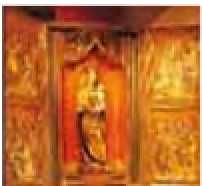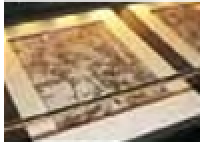Travel Reference
In-Depth Information
Floorplan of
St Agnes'
Convent
Vy√√í Brod
Altarpiece
The 14th-century
cycle begins with the
Annunciation
, then
proceeds through the
Adoration of the Magi
(below)
to
Pentecost
(right)
. The creator of
these beautiful panels
is unknown.
0 8 4 3
6
7
1
2
9
5
Capuchin Cycle
The origin of these 14
panels is unknown. The
Virgin Mary is flanked by
St Peter on the left and
Christ on the right.
Entrance
Puchner
Altarpiece
St Agnes gave up a life at
court to pursue a spiritual
vocation. She is typically
depicted nursing the sick
on this 15th-century
altarpiece.
Apocalypse Cycle
Although he's
considered the foremost
German Renaissance
artist, Albrecht Dürer is
probably best known for
woodcuts such as this
series of 15 from 1498
(below)
, which retain a
strong Gothic flavour.
Velhartice
Altarpiece
Originating in south
Bohemia around 1500,
this is a rare example of
a completely preserved
altar
(above)
. Beneath the
Madonna, cherubs hold
the vera icon.
Martyrdom of
St Florian
Albrecht Altdorfer
created this painting as
part of a multipanel altar
featuring scenes from
the legend of St Florian.
Other pieces from the
series are in Florence.
St Agnes
St Agnes of Bohemia
was a powerful figure in
medieval politics. Pope
Gregory IX granted
special privileges to her
convent and his succes-
sor Innocent IV sent
priceless relics to be
housed there. Agnes
died in 1282, but her
influence on Czech state-
hood was felt centuries
later when, in 1989,
Pope John Paul II
canonized her; five days
later, the Velvet Revolu-
tion began
(see p35)
.
Works of Master
Theodoricus
Parts of an altar set on
loan from Karl√tejn Castle,
are
St Luke, St Charle-
magne
,
St Catherine
,
St
Matthew
,
St Ambrose
and
St Gregory.
T∫ebo∏ Altarpiece
Only three of the five
double-sided panels of the
14th-century T∫ebon Altar-
piece
(right)
have sur-
vived to the present day.
29

















